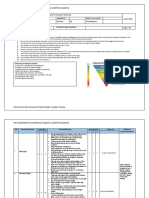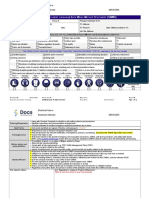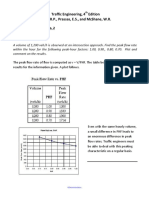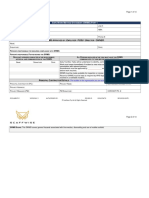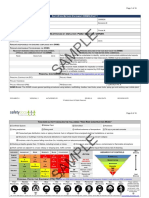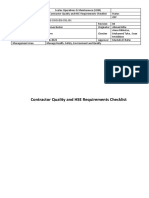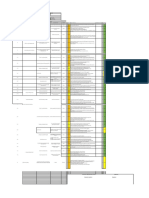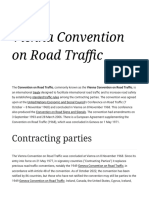Swms
Swms
Uploaded by
Ahmed AbdulmajeedCopyright:
Available Formats
Swms
Swms
Uploaded by
Ahmed AbdulmajeedOriginal Title
Copyright
Available Formats
Share this document
Did you find this document useful?
Is this content inappropriate?
Copyright:
Available Formats
Swms
Swms
Uploaded by
Ahmed AbdulmajeedCopyright:
Available Formats
{company_name}
{%company_logo} {company_address}
{company_abn}
CONCRETE FOUNDATIONS EXCAVATING - POURING SAFE WORK METHOD STATEMENT (SWMS)
Business Contact: Phone #: Principal Contractor (PC):
Responsible person (for monitoring SWMS and work): PC Address:
Signature: Date: PC Phone #: Date SWMS provided to PC:
Contact Phone #: Job Site Address:
E
If yes – This SWMS must align with requirements of the Site
SITE MANAGEMENT PLAN Is the work associated with a Construction Project? Yes No Management Plan in place for the Construction Project.
PL
THIS WORK ACTIVITY INVOLVES THE FOLLOWING “HIGH-RISK CONSTRUCTION WORK” (HRCW - IDENTIFIED IN THE JOB TASK COLUMN)
Confined spaces Mobile plant movement Demolition of a load-bearing structure Asbestos disturbance
Using explosives Diving work Artificial extremes of temperature Tilt-up or pre-cast concrete
Pressurised gas distribution mains or piping chemical, fuel or refrigerant lines energised electrical installations or services
M
Structures or buildings involving structural alterations or repairs that require temporary support to prevent collapse
Involves a risk of a person falling from 2m or more, including work on telecommunications towers Work in a ceiling space (W.A. Only)
Working at depths greater than 1.5 metres, including tunnels or mines Work in an area that may have a contaminated or flammable atmosphere
SA
Work carried out adjacent to a road, railway or shipping lane, traffic corridor In or near water or other liquid that involves the risk of drowning
WORKING WITH A RISK OF A FALL OVER 2 METRES. Select the fall from height 'hierarchy of control level' considered when establishing controls:
LEVEL 1: Eliminate hazards by performing the work on solid ground/solid construction LEVEL 4: Use a fall arrest system e.g., safety harness
LEVEL 2: Use a passive fall prevention device e.g., edge protection LEVEL 5: Use a ladder or implement administrative controls e.g., SWMS
LEVEL 3: Use a work positioning system e.g., Other?
Please describe why it is not reasonably practicable to use higher-order control measures. E.g. The job is less than 5 minutes on a ladder.
DOCUMENT #: VERSION #: 1 DEVELOPED BY AUTHORISED BY REVIEW #:
CONCRETE FOUNDATIONS EXCAVATING - POURING © SafetyCulture All Rights Reserved ISSUE DATE: REVISION DATE: Page 1 of 16
SAFE WORK METHOD STATEMENT
{company_name}
{%company_logo} {company_address}
{company_abn}
RESPONSIBLE
JOB TASK HAZARDS RISK CONTROL MEASURES PERSON
conditions & Hyperthermia 3H Ensure that workers trained to recognise the symptoms of hyperthermia and hypothermia awareness of
prepare Hot conditions. Ensure: Cold conditions. Ensure: weather
Hypothermia o Suitable protective clothing o Schedule warm-up breaks conditions
o Sun brim on hard hats o Hold breaks inside
o Safety glasses - UV rated o Dress warmly in layers Workers to
o Use 30+ sunscreen on exposed o Stay dry (wet clothing chills the body rapidly) follow controls
skin o Workers must get out of the cold as soon as they and make
o Adequate drinking water can if starting to feel symptoms supervisor
E
o Access to shade on breaks o Alcohol, cigarettes, caffeine and certain aware of any
o Adequate breaks. medications increase susceptibility to cold. issues
PL
4. HRCW Unauthorised 3H Erect barricades with adequate signage: Supervisors
Work area access to the o Erected before the commencement of work to check all
set-up work area o Always kept in position until the work completed and safe to remove controls in
o Regularly inspected and maintained place and
Use lock-out procedures to prevent unauthorised use of plant followed
Provide information to workers and other people on-site advising them of the exclusion zones
Delivery of goods, materials and equipment should only be made through the public areas during Workers to
Work adjacent
to road & public
4A
M
off-peak periods
Provide supervision so that no unauthorised person enters an exclusion zone.
Where setting up on a road or other public place an alternative footpath provided and protective
fitted around the work area to prevent harm to passers-by
follow controls
and make
supervisor
aware of any
SA
issues
Where necessary, traffic control put in place to provide safe road use
If setting up roadside – comply with local laws and permits
Erect any barriers & signage necessary to keep others safe and aware
If temporary road traffic control is required (e.g. parking on-road or pedestrian management):
o Approvals and permits are sought from the local council and/or state road transport
departments where necessary
o Only accredited traffic controllers are to perform traffic control duties
o All traffic control measures in place implemented as per Australian Standard AS 1742.3–
2009: Manual of Uniform Traffic Control Devices, Part 3: Traffic Control for Works on Roads
(‘AS 1742.3-2009’) or other requirements as per permit conditions
o Traffic controllers must have the required accreditation to perform traffic control duties
o Traffic controllers must have sufficient experience to set-up and control traffic safely and
efficiently.
DOCUMENT #: VERSION #: 1 DEVELOPED BY AUTHORISED BY REVIEW #:
CONCRETE FOUNDATIONS EXCAVATING - POURING © SafetyCulture All Rights Reserved ISSUE DATE: REVISION DATE: Page 4 of 16
SAFE WORK METHOD STATEMENT
{company_name}
{%company_logo} {company_address}
{company_abn}
RESPONSIBLE
JOB TASK HAZARDS RISK CONTROL MEASURES PERSON
Clearly defined work areas to ensure no vegetation clearing occurs outside of the work area
No burning of vegetation
Notify site manager if any accidental or unintended vegetation clearing occurs
Cease immediately any work that causes the unintended vegetation clearing to occur
Ensure that plant is washed free of dirt, vegetation, debris before travelling between sites.
Vehicle movement - Follow the TMP, only travel on established tracks and roads
Use designated entry and exit points
E
Cultural heritage - Training and instruction provided concerning the heritage values, historical
significance, cultural relevance or sensitivity of the area
Comply with the conditions of any licence, approval or permit issued by the relevant planning
authorities relating to cultural heritage
PL
No disturbance of heritage values or items
No complaints or allegations of unauthorised disturbance of heritage values or items
Due diligence in the supervision, inspection and monitoring of works to ensure that the
necessary licence, approval and permit conditions complied with
Any disturbance is minimised, and buffer zones or segregated areas are maintained
If an unknown condition arises, e.g. cultural heritage relic: Stop work and notify the site manager
Terrestrial fauna - No domestic animals are to be taken on-site
6. House
keeping
Slips
Trips
Falls
3H
M
Ensure all food scraps placed in lidded bins.
Maintain housekeeping throughout the shift & clean-up
Ensure sufficient lighting to detect changes in level (using temporary lighting as required)
Do not jump from elevated edges >180mm, step carefully and use prepared access areas
Supervisor
and workers
to ensure
SA
The work area is clean and uncluttered as possible control
Do not place equipment where it could become a trip hazard measures
Check for stored items, corners or other obstructions that could cause tripping followed
Ensure there is room to manoeuvre and no obstacles in the way
Check the end destination is prepared correctly for placement of the materials/equipment
Clean spills immediately
Footwear is suitable. Snug-fitting shoes/boots with flat, non-slip soles, no loose soles, long laces,
oily soles, or caked with mud or other contaminants.
7. Manual tasks Musculoskeletal 3H Materials/equipment placed as close to the work area as possible Supervisor
(MSD) injuries Weight of an object should be known; avoid lifting loads more than 1/4 of your body weight and workers
Do not use extreme force to move items to ensure
Hold lifted items close to the body whenever possible: control
o Keeping knees bent and back straight and lift, unload keeping knees bent measures
Use team lifts and mechanical means for heavy items followed
DOCUMENT #: VERSION #: 1 DEVELOPED BY AUTHORISED BY REVIEW #:
CONCRETE FOUNDATIONS EXCAVATING - POURING © SafetyCulture All Rights Reserved ISSUE DATE: REVISION DATE: Page 6 of 16
SAFE WORK METHOD STATEMENT
You might also like
- 8168 - Aircraft Operations - Flight Procedures (Vol III)Document162 pages8168 - Aircraft Operations - Flight Procedures (Vol III)Dimas MohammedNo ratings yet
- Risk Assessment For External Façade & Canopies CleaningDocument6 pagesRisk Assessment For External Façade & Canopies Cleaningjulius50% (2)
- Dtta PDFDocument20 pagesDtta PDFzacklawsNo ratings yet
- Risk Assessment For External Façade & Canopies CleaningDocument8 pagesRisk Assessment For External Façade & Canopies CleaningFrancis Enriquez Tan100% (2)
- Concrete Placement Finishing Swms 10064-7Document12 pagesConcrete Placement Finishing Swms 10064-7JamesNo ratings yet
- Excavation Working in Trenches Swms 10281-6Document17 pagesExcavation Working in Trenches Swms 10281-6James100% (1)
- Electric Powerlines Working Near Swms 10590-3Document12 pagesElectric Powerlines Working Near Swms 10590-3JamesNo ratings yet
- Jsa Dismantling The Wooden Framework-NewDocument3 pagesJsa Dismantling The Wooden Framework-NewHow Chin Engineering Sdn BhdNo ratings yet
- Risk Assessment - Ad-456 - Installation and Testing Vav Boxes & Controls in OmbDocument9 pagesRisk Assessment - Ad-456 - Installation and Testing Vav Boxes & Controls in Ombnsadnan100% (1)
- Master Builders SA - Safe Work Method Statement - Timber Roof Truss Installation CraneDocument6 pagesMaster Builders SA - Safe Work Method Statement - Timber Roof Truss Installation CraneDaniel Julian100% (1)
- 1、The maps below show the centre of a small town called Islip as it is now, and plans for its development. Islip 的小镇的中心,并计划开发它。Document53 pages1、The maps below show the centre of a small town called Islip as it is now, and plans for its development. Islip 的小镇的中心,并计划开发它。Jessica HB ZhangNo ratings yet
- حلول مسائل هندسة المرور Traffic Engineering الطبعة الرابعةDocument66 pagesحلول مسائل هندسة المرور Traffic Engineering الطبعة الرابعةMuthanna HikmatNo ratings yet
- MCDOT Roadway Design ManualDocument264 pagesMCDOT Roadway Design ManualAnthony GravagneNo ratings yet
- 10147-9 SampleDocument3 pages10147-9 SampleSun ShadeNo ratings yet
- 10090_Electrical New Installation Safe Work Method Statement-SAMPLEDocument3 pages10090_Electrical New Installation Safe Work Method Statement-SAMPLESYED FAWAD HANIFNo ratings yet
- Fencing Safe Work Method Statement-SAMPLEDocument3 pagesFencing Safe Work Method Statement-SAMPLErohantparrNo ratings yet
- Rope Access Safe Work Method Statement-SAMPLEDocument3 pagesRope Access Safe Work Method Statement-SAMPLEBafana HlatshwayoNo ratings yet
- Shade Sail Installation Safe Work Method Statement-SAMPLEDocument3 pagesShade Sail Installation Safe Work Method Statement-SAMPLEMohammed MustafaNo ratings yet
- Mobile Crane Safe Work Method Statement-SAMPLEDocument3 pagesMobile Crane Safe Work Method Statement-SAMPLEkwame fosterNo ratings yet
- SWMS Template 30013 14Document6 pagesSWMS Template 30013 14Zeeshan AliNo ratings yet
- Concrete Pumping (Boom-Line) SWMS 10065-7Document13 pagesConcrete Pumping (Boom-Line) SWMS 10065-7caringbahngconstructionsNo ratings yet
- Construction Labourer Swms 10556-4Document16 pagesConstruction Labourer Swms 10556-4JamesNo ratings yet
- Bench-Top Installation - Stone Safe Work Method Statement-SAMPLEDocument3 pagesBench-Top Installation - Stone Safe Work Method Statement-SAMPLEsrahman505No ratings yet
- 10272_Tower Crane Safe Work Method Statement-SAMPLEDocument3 pages10272_Tower Crane Safe Work Method Statement-SAMPLEDaffa AlifNo ratings yet
- JSA Installation-Fire-Alarm-SystemDocument12 pagesJSA Installation-Fire-Alarm-Systemuz9143895No ratings yet
- Erecting Suspended Powered Scaffolds SWMSDocument3 pagesErecting Suspended Powered Scaffolds SWMSJHM100% (1)
- Risk Assessment - Ad-417 - Installation of Do Meter, Cable Trench Excavation, Cable Installation and TestingDocument12 pagesRisk Assessment - Ad-417 - Installation of Do Meter, Cable Trench Excavation, Cable Installation and Testingnsadnan100% (1)
- Safe Work Method Statement Hot Works: OST Constructional Projects LLCDocument8 pagesSafe Work Method Statement Hot Works: OST Constructional Projects LLCIrfan UllahNo ratings yet
- Asphalt Paver Safe Work Method Statement 10454-2 - SAMPLEDocument4 pagesAsphalt Paver Safe Work Method Statement 10454-2 - SAMPLEGeo WorkNo ratings yet
- TA AsbestosDocument8 pagesTA AsbestosTony ZhangNo ratings yet
- Whs f014 Safe Work Method Statement FormDocument9 pagesWhs f014 Safe Work Method Statement FormTamo Kim ChowNo ratings yet
- Work Plan (Drain Pipe, Sprinkler and Hose Reel Dismantle and Modification Work)Document4 pagesWork Plan (Drain Pipe, Sprinkler and Hose Reel Dismantle and Modification Work)Ahgilan VijayanNo ratings yet
- Operation of Vehicle Mounted Crane: Safe Work Method StatementDocument9 pagesOperation of Vehicle Mounted Crane: Safe Work Method StatementMuhd AqibNo ratings yet
- Ats 1Document1 pageAts 1daniel guevaraNo ratings yet
- SWMS Mobile ScaffoldingDocument14 pagesSWMS Mobile Scaffoldingnur agusNo ratings yet
- SS WHS SAF 000 Safe Work Method Statement PaintingDocument7 pagesSS WHS SAF 000 Safe Work Method Statement PaintingUma shankar BhartiNo ratings yet
- ERECTION, MODIFICATION & DISMANTLING OF SCAFFOLDING WORKS - Risk Assessment - REV01Document10 pagesERECTION, MODIFICATION & DISMANTLING OF SCAFFOLDING WORKS - Risk Assessment - REV01SolimanNo ratings yet
- Iperc ContinuoDocument2 pagesIperc ContinuoMilagros Avila CuevasNo ratings yet
- Sample: V S T S W M S (SWMS)Document3 pagesSample: V S T S W M S (SWMS)SteveNo ratings yet
- Manual Excavation For Identified Depth and Elevation of Existing PipelineDocument15 pagesManual Excavation For Identified Depth and Elevation of Existing PipelineshahbazchafekarNo ratings yet
- Documents - Pub - Heights Working at Swms No Safe Work Method This Swms Covers The Risk ManagementDocument16 pagesDocuments - Pub - Heights Working at Swms No Safe Work Method This Swms Covers The Risk ManagementVepxvia NadiradzeNo ratings yet
- 3200-0564-SWMS-005 PV Array,Combiner boxDocument9 pages3200-0564-SWMS-005 PV Array,Combiner boxVincent QiaoNo ratings yet
- Concrete Piling SWMS 10612-3 - SAMPLEDocument3 pagesConcrete Piling SWMS 10612-3 - SAMPLELeonieNo ratings yet
- Painting (General Safety) SWMS 10183-4 - SAMPLEDocument6 pagesPainting (General Safety) SWMS 10183-4 - SAMPLEKunal PanchalNo ratings yet
- Jha - 100822Document2 pagesJha - 100822Vina QuipanesNo ratings yet
- 02. JSA Chanage Dies Slip With CuttingDocument2 pages02. JSA Chanage Dies Slip With CuttingSyD BaiduriNo ratings yet
- Lifting Work PermitDocument1 pageLifting Work Permitmohammedderhmalathwri2002No ratings yet
- MS - RA Hot WorksDocument3 pagesMS - RA Hot Worksumerbajwa333No ratings yet
- RAMS Air Conditioning Unit InstallDocument10 pagesRAMS Air Conditioning Unit InstallMohammad SaleemNo ratings yet
- 10 Wqe 281Document3 pages10 Wqe 281hysh89No ratings yet
- Earthmoving Attachment Maintenance: Safe Operational ProcedureDocument3 pagesEarthmoving Attachment Maintenance: Safe Operational ProcedureJames100% (1)
- SOP For Compressors 009Document2 pagesSOP For Compressors 009Clifford ThackwrayNo ratings yet
- SIM ARABIA - JSA For Excavation and Backfilling Works (Irrigation System)Document11 pagesSIM ARABIA - JSA For Excavation and Backfilling Works (Irrigation System)Rana AhmedNo ratings yet
- Safety Method Statement Template & Guidelines.: Hse - Gov.UkDocument4 pagesSafety Method Statement Template & Guidelines.: Hse - Gov.UkFarouk MohamedNo ratings yet
- JSA For Errection of Batching PlantDocument4 pagesJSA For Errection of Batching Plantasamrat582No ratings yet
- CLC - 9040 5.19.3 Job Safety Practices Rev 02 Radiography ActivityDocument4 pagesCLC - 9040 5.19.3 Job Safety Practices Rev 02 Radiography ActivityshafieNo ratings yet
- Job Safety AnalysisDocument3 pagesJob Safety AnalysisAndhy DhannyNo ratings yet
- Drilling Piling Swms 10 15763 SAMPLEDocument7 pagesDrilling Piling Swms 10 15763 SAMPLEAlok JagannathNo ratings yet
- Example Blank SWMSDocument5 pagesExample Blank SWMSkylejlancasterNo ratings yet
- How Chin Engineering: Job Safety AnalysisDocument5 pagesHow Chin Engineering: Job Safety AnalysisHow Chin Engineering Sdn BhdNo ratings yet
- 02. JSA Cutting Conductor PipeDocument2 pages02. JSA Cutting Conductor PipeSyD BaiduriNo ratings yet
- Risk Assessment KURA WEST XINGDocument14 pagesRisk Assessment KURA WEST XINGMamuka ShaorshadzeNo ratings yet
- Safe Operating Procedure No: TS - WE02 Hot Work ProceduresDocument9 pagesSafe Operating Procedure No: TS - WE02 Hot Work ProceduresDaniel DDDNo ratings yet
- Programmatic Safety Plan (PSP) : Required For High Risk Routine & Repetitive WorkDocument4 pagesProgrammatic Safety Plan (PSP) : Required For High Risk Routine & Repetitive WorkSteve ParkerNo ratings yet
- ACWA - Supplier GuidesDocument38 pagesACWA - Supplier GuidesAhmed AbdulmajeedNo ratings yet
- HSE PolicyDocument2 pagesHSE PolicyAhmed AbdulmajeedNo ratings yet
- Acwa FaqDocument3 pagesAcwa FaqAhmed AbdulmajeedNo ratings yet
- NCSCMSP-002FM-014 Acknowledgement of HSE PolicyDocument2 pagesNCSCMSP-002FM-014 Acknowledgement of HSE PolicyAhmed AbdulmajeedNo ratings yet
- ESMS Annex 29.17 - Tools & Machines Checklists FormatDocument37 pagesESMS Annex 29.17 - Tools & Machines Checklists FormatAhmed AbdulmajeedNo ratings yet
- Contractor Quality and HSE Requirements ChecklistDocument9 pagesContractor Quality and HSE Requirements ChecklistAhmed AbdulmajeedNo ratings yet
- Issue-Based Risk Assessment Sub-Contractor ITS Filters CleaningDocument5 pagesIssue-Based Risk Assessment Sub-Contractor ITS Filters CleaningAhmed AbdulmajeedNo ratings yet
- LTO Online Exam ReviewerDocument10 pagesLTO Online Exam RevieweruarcayaNo ratings yet
- 416 EssayDocument6 pages416 EssayMuhammad HafizNo ratings yet
- Minutes of Meeting #42Document13 pagesMinutes of Meeting #42PHH9834No ratings yet
- Colreg KonvencijaDocument11 pagesColreg KonvencijaDarko ErcegovicNo ratings yet
- Asshto LRFDDocument108 pagesAsshto LRFDJose Belito Belito ManchaNo ratings yet
- Lab 2 HighwayDocument6 pagesLab 2 HighwayNurfazlin Mohamad ZamriNo ratings yet
- Survey QuestionnaireDocument3 pagesSurvey Questionnaireandrewtabula22No ratings yet
- ATC Flight Plan FR 2334/13 JAN/AGP-AMS A/C: EIFRXDocument72 pagesATC Flight Plan FR 2334/13 JAN/AGP-AMS A/C: EIFRXPABLO BAÑO GARRENo ratings yet
- Complete StreetsDocument28 pagesComplete StreetsAdithya R SNo ratings yet
- Mars Inc WorkPlace Transport HSE Management Standard Specification Final V2 020208sDocument12 pagesMars Inc WorkPlace Transport HSE Management Standard Specification Final V2 020208sPankaj BendaleNo ratings yet
- At Marked Stop Line, Before Entering The Crosswalk, or Before Entering The Intersection If There Is No CrosswalkDocument5 pagesAt Marked Stop Line, Before Entering The Crosswalk, or Before Entering The Intersection If There Is No CrosswalkMrudul PatilNo ratings yet
- Zenteus Truck Inn Business PlanDocument135 pagesZenteus Truck Inn Business PlanGaopotlake Mokokong100% (1)
- EVAL AIR TRAFFIC SERVICES LIFT - Exam 1Document7 pagesEVAL AIR TRAFFIC SERVICES LIFT - Exam 1Tio Norman WicaksonoNo ratings yet
- Feeder Road Design Manual and SpecificationsDocument169 pagesFeeder Road Design Manual and SpecificationsEmmanuel ClayeaNo ratings yet
- 2007 333Document13 pages2007 333Zeroseveen SeveenNo ratings yet
- Everland Theme Park, KoreaDocument2 pagesEverland Theme Park, KoreaSharvin NeshNo ratings yet
- Vienna Convention On Road Traffic - WikipediaDocument29 pagesVienna Convention On Road Traffic - Wikipediaamirj3 shahNo ratings yet
- Helen ZewdieDocument72 pagesHelen Zewdiemele ankeNo ratings yet
- AA 376/17 JAN/LAX-SLC: - Not For Real World NavigationDocument23 pagesAA 376/17 JAN/LAX-SLC: - Not For Real World NavigationHog FliesNo ratings yet
- Quiz Unit 1 (Calificable) - Revisión Del IntentoDocument5 pagesQuiz Unit 1 (Calificable) - Revisión Del IntentoFerney Fernandez CorteceroNo ratings yet
- 1152 Road Openings and Restoration Utility Authorities Rev 0Document25 pages1152 Road Openings and Restoration Utility Authorities Rev 0Moren AlfonsoNo ratings yet
- (EC) 3.5-4.5 - Session 24Document145 pages(EC) 3.5-4.5 - Session 24maiha341986No ratings yet
- Publish PaperDocument4 pagesPublish PaperpoojiNo ratings yet
- Air Traffic Plans and PublicationsDocument5 pagesAir Traffic Plans and PublicationsdwrreNo ratings yet
- Lsza App1 Igs01Document1 pageLsza App1 Igs01matteomanmanNo ratings yet

